Ecuador says it is ready to act against Fusarium plague and keep banana exports flowing
GUAYAQUIL, Ecuador, Oct. 21, 2025 /PRNewswire/ -- Fusarium TR4, the most feared current plague for banana plantations, which has already caused major damage in Latin American countries such as Colombia, Venezuela and Peru, is threatening Ecuador, the world's leading banana exporter. The country has spent years preparing protocols to contain any outbreak of the fungus and continue supplying bananas to more than 70 countries around the world.
So far, since Fusarium was first confirmed in Latin America six years ago, Ecuador has managed to keep the pathogen outside its borders. However, a recent suspected case on a seven-hectare farm in Santa Rosa, near the border with Peru, triggered all the containment protocols developed over the years.
The case, still awaiting confirmation, has prompted immediate containment measures and has become one of the main topics of discussion at Banana Time 2025, which brought together experts from countries such as Brazil, Colombia, Venezuela, and Peru in Guayaquil, Ecuador, to share their experiences and latest scientific advances in neutralizing TR4.
At the meeting, organized by the Association of Ecuadorian Banana Exporters (AEBE), the country's main export guild, Agriculture, Livestock and Fisheries Minister Danilo Palacios expressed confidence in the sector's ability to face major threats, recalling successful cases such as the control of black sigatoka.
"This alert in Santa Rosa has activated the contingency plan," said the Agriculture Ministry's Undersecretary for Strategic Agricultural Chains, Gustavo Cepeda, who added that a training plan for producers is being developed.
"All the efforts we make with financing, credits, or the delivery of kits will not be enough if there is no shared responsibility from each producer and every actor in the chain," he said, announcing the activation of an inter-institutional committee that brings together all stakeholders in the value chain to coordinate joint commitments and response actions.
The examples Ecuador looks to are countries such as Colombia, Australia, and the Philippines, which have already managed to control the fungus's spread. The key, experts agreed, has been training in biosecurity measures, scientific research, and cooperation between the public sector, trade associations and academia.
Photo - https://mma.prnewswire.com/media/2800308/AEBE.jpg




Artikel teilen